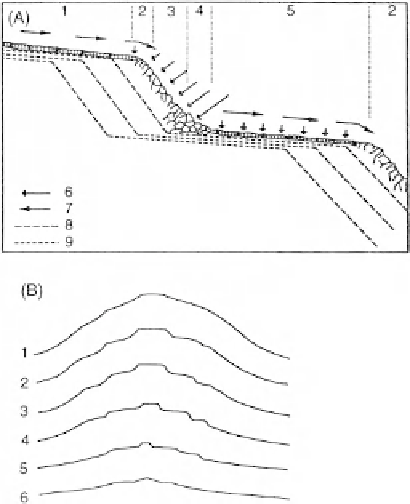Geology Reference
In-Depth Information
Figure 9.15.
The altiplanation (cryoplanation) concept as proposed by S. G. Boch and I. I. Krasnov
(1943) for the Ural Mountains, Russia. (A) Altiplanation terrace development. Legend: (1) fl at
terrace, or step (slope angle
3-5°); (2) edge/border of terrace; (3) terrace riser with bedrock
exposed; (4) frost-riven rock face; (5) lower level terrace; (6) triangular-headed arrows signify
varying intensities of frost weathering; (7) pointed arrows indicate direction of material transport
across the terrace; (8) successive stages of inferred retreat of the frost-riven rock face; (9) successive
stages in downwearing of the terrace. (B) Proposed stages of landscape evolution through altiplana-
tion: stage 1, initial topography prior to commencement of periglacial conditions; stages 2-5, devel-
opment of fl at summits and/or interfl uves, and “stepped” lower profi les and/or tors; stage 6, ultimate
cryoplanation of the landscape and formation of a “frost and solifl uction peneplain.” From Boch
and Krasnov (1943); translated and reproduced in Evans (1994).
∼
in origin. For example, on the Yukon-Alaska border, the benches truncate dip directions
and attitudes in the underlying bedrock (French et al., 1983, pp. 61-63; Reger and Péwé,
1976). Moreover, most terraces that are described appear to be relict. Their age of forma-
tion is uncertain. In the Richardson Mountains of northern Yukon Territory, analysis of
the silty veneer, and the weathering of quartzite bedrock on which bedrock terraces are
formed, fail to demonstrate their active formation or the process(es) involved (Lamirande
et al., 1999; Lauriol et al., 1997). On Svalbard, bedrock erosional surfaces initially
attributed to “altiplanation” (Waters, 1962) were subsequently found to be raised beaches
(Péwé et al., 1982).
Notwithstanding these problems, the cryoplanation concept is a useful working model
for landscape evolution under cold, non-glacial conditions. It underlies the periglacial
“cycle of erosion” fi rst proposed by L. C. Peltier (1950). The initial assumption is that an
existing non-periglacial landscape is subject to intense frost action and solifl uction. An
initial stage begins with downslope movement of soil and frost debris that exposes bedrock
on upper slopes. The latter is then subject to further frost shattering, rockfall, and retreat.

